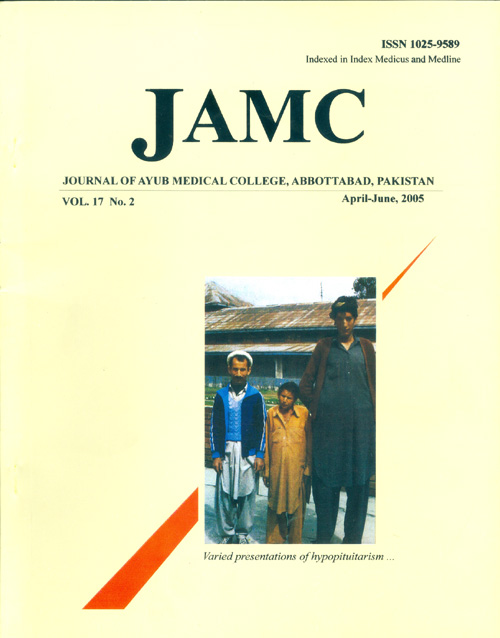FREQUENCY AND TREATMENT OF URINARY TRACT INFECTION IN CHILDREN SUBJECTED TO URINE CULTURE, IN SANA'A, YEMEN
Abstract
Background: This study was carried out to estimate the frequency of urinary tract infection among children subjected to urine culture presenting to Sam Hospital, Sana'a city, Yemen and to determine the susceptibility of the isolated bacteria to the antibiotics. Methods: Record-based study was done in Sam Hospital in Sana'a city Yemen during three years 1/ 1/ 1999-31/ 12 / 2001. Out of 70500 patients seen for different causes through that period 820 (1.16%) having urinary symptoms (fever, rigor, vomiting, frequency or screams during the act of urination) were subjected to urine culture. Data about age and sex were also collected. Results: Frequency of urinary tract infections among children examined by urine culture was 36.8% (n=302), with mean age of 7.6 years, 272 (90.1%) of them were females, and 30 (9.9%) were males. More than half 154(51%) of infected patients were less than three year old. The isolated bacteria was Escherichia.coli 201 (66.3 %) followed by Staphylococcus suprofyticus 45 (14.9%, Proteus spp 15 (4.9%), Klebseilla 12 (3.9%) then Enterococcus spp 12 (3.9%). Sensitivity of E. coli, to Nalidexic acid was 70%, to Amoxicillin/Clavulanic acid was 29.9%, to Co-trimoxasole was 16.4%, and to Nitrofurantoin was 15.9%. Conclusion: The majority of the infected patients were females and the highest frequency of the disease was in the first three years of age. The most common isolated microorganism was E.coli followed by Staphylococcus suprofyticus, Proteus spp, then Enterococcus spp. The highly active antibiotic for most organisms isolated was Nalidexic acid, then amoxicillin/ clavulanic acid. Nalidexic acid can be used as a first line empiric treatment and/or prophylaxis of UTI in children.
Keywords: Urinary tract infection, children, Yemen.
References
Paterson A. Urinary tract infection: an update on imaging strategies Eur Radiol 2004;14 S 4:L89-100
Adjei O, Opoku C. Urinary tract infections in African infants. Int J Antimicrob Agents 2004;24 S1:32-4.
Larcombe J. Urinary tract infection in children. BMJ 1999:1173-5.
Behrman RE, Kliegman RM, Jenson HB. Nelson Textbook of pediatrics. 16th edition. Philadelphia: WB Saunders company;2000.
Gunsar C, Kurutepe S, Alparslan O, Yilmaz O, Daglar Z, Sencan A, et al. The effect of circumcision status on periurethral and glanular bacterial flora. Urol Int 2004;72(3):212-5
Lipsky BA. Urinary tract infection. Ann Intern Med 1989;110:138-50.
Graef JW. Manual of Pediatric Therapeutics. Fifth Egyptian edition. Cairo: Mass publishing Co. 1996.
Malhotra SM, Kennedy WA. Urinary tract infections in children: treatment. Urol Clin North Am 2004;31(3): 527-34.
Lulich JP, Osborne CA. Urine culture as a test for cure: why, when, and how?. Vet Clin North Am Small Anim Pract 2004;34(4):1027-41.
Bartges JW. Diagnosis of urinary tract infections. Vet Clin North Am Small Anim Pract 2004; 34(4): 923-33.
Miller LG, Tang AW. Treatment of uncomplicated urinary tract infections in an era of increasing antimicrobial resistance. Mayo Clin Proc. 2004;79(8): 1048-53.
Ladhani S, Ggrasnden W. Increasing antibiotic resistance among urinary tract infection isolates. Archives of Disease in Children 2003;88(5):444-5.
Belet N, Islek I, Belet U, Sunter AT, Kucukoduk S. Comparison of trimethoprim - sulfamethoxazole, cephadroxil and cefprozil as prophylaxis for recurrent urinary tract infections in children. J Chemother 2004; 16(1): 77-81.
Kaneko K, Ohtomo Y, Shimizu T, Yamashiro Y, Yamataka A, Miyano T. Antibiotic prophylaxis by low-dose cefaclor in children with vesicoureteral reflux. Pediatr Nephrol 2003;18(5): 468-70.
Hutchison JH, Cockburn F. Practical pediatric problems. 6th edition. London: Lliyd-luke (medical books);1986.
Downloads
How to Cite
Issue
Section
License
Journal of Ayub Medical College, Abbottabad is an OPEN ACCESS JOURNAL which means that all content is FREELY available without charge to all users whether registered with the journal or not. The work published by J Ayub Med Coll Abbottabad is licensed and distributed under the creative commons License CC BY ND Attribution-NoDerivs. Material printed in this journal is OPEN to access, and are FREE for use in academic and research work with proper citation. J Ayub Med Coll Abbottabad accepts only original material for publication with the understanding that except for abstracts, no part of the data has been published or will be submitted for publication elsewhere before appearing in J Ayub Med Coll Abbottabad. The Editorial Board of J Ayub Med Coll Abbottabad makes every effort to ensure the accuracy and authenticity of material printed in J Ayub Med Coll Abbottabad. However, conclusions and statements expressed are views of the authors and do not reflect the opinion/policy of J Ayub Med Coll Abbottabad or the Editorial Board.
USERS are allowed to read, download, copy, distribute, print, search, or link to the full texts of the articles, or use them for any other lawful purpose, without asking prior permission from the publisher or the author. This is in accordance with the BOAI definition of open access.
AUTHORS retain the rights of free downloading/unlimited e-print of full text and sharing/disseminating the article without any restriction, by any means including twitter, scholarly collaboration networks such as ResearchGate, Academia.eu, and social media sites such as Twitter, LinkedIn, Google Scholar and any other professional or academic networking site.










